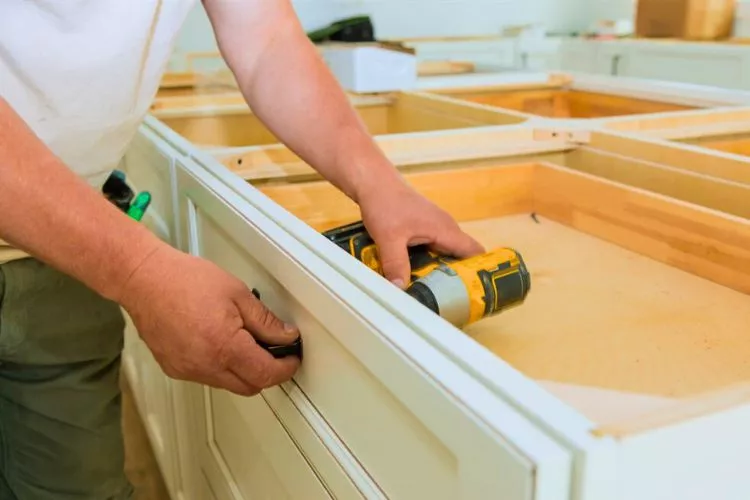A kitchen island can be a fantastic addition to your home, providing extra counter space, storage, and a place for family and friends to gather.
However, there may come a time when you need to remove a kitchen island, whether for a renovation, to open up space, or simply to change the layout of your kitchen.
In this article, I will guide you through removing a kitchen island safely and efficiently. We have covered everything from the necessary tools and preparation to the step-by-step process.
Let’s dive in and learn how to reclaim your kitchen space!

how to remove a kitchen island? (My Guide)
For various reasons, someone may want to remove a kitchen island, such as renovating the kitchen, creating more open space, or changing the layout.
Regardless of the reason, doing it safely and efficiently is essential to avoid damage or injuries.
This guide will provide step-by-step instructions on how to remove a kitchen island, including the necessary tools, materials, and precautions to take.
Tools and Materials
Before starting the process, gather the following tools and materials:
- Screwdriver
- Utility knife
- Pry bar
- Hammer
- Wrench
- Pliers
- Work gloves
- Safety goggles
- Drop cloth or plastic sheeting.
- Bucket or container for debris
Step 1: The Preparation Stage
Before you begin, take the following precautions to ensure a safe and efficient removal process:

- Turn off the power supply to the kitchen island, especially if there are built-in electrical outlets or appliances.
- Remove any appliances, such as a microwave or oven that may be attached to the island.
- Empty any cabinets or drawers on the island to lighten the load and avoid damage to your belongings.
- Cover the surrounding floor with a drop cloth or plastic sheeting to protect it from scratches and debris.
Step 2: the Removal Stage
Follow these steps to safely remove your kitchen island:
- Detach the countertop: Use a utility knife to cut through any caulk or adhesive between the countertop and the base. This will help to separate the two components more easily. Next, insert a pry bar between the countertop and the base, gently applying pressure to lift the countertop. Be sure to work slowly and carefully, moving along the entire edge of the countertop to avoid damaging the material or the floor beneath it. If the countertop is particularly heavy or large, ask for assistance to prevent injury or damage.
- Remove the base and legs or supports: With the countertop removed, inspect the island’s base to identify any screws, bolts, or brackets holding it in place. Use a screwdriver or wrench to remove these fasteners, keeping track of them for future use or disposal. If the island is attached to the floor with adhesive or screws, use a pry bar to carefully lift the base away from the floor, working around the entire perimeter to ensure an even and controlled removal.
- Disassemble the island: If it has multiple sections, such as cabinets, shelves, or drawers, use a screwdriver, wrench, or pliers to disassemble it into smaller, more manageable pieces. This may involve removing screws or bolts connecting the sections and detaching any hinges, slides, or other hardware. Label or organize the hardware and components for easy reassembly or disposal.
- Remove the island: With the island disassembled, carefully lift and carry the pieces out of the kitchen. If the island is too heavy or unwieldy, consider using a dolly or enlisting the help of a friend or family member to assist with the removal. Be mindful of doorways, hallways, and other obstacles when transporting the island components to prevent damage to your home or injury to yourself and others.
Step 3: The Cleaning up Stage
Once the kitchen island has been removed, follow these steps to clean up:

- Sweep or vacuum the area to remove any debris, dust, or remnants of adhesive or caulk.
- Use a scraper or putty knife to remove any stubborn adhesive or caulk residue from the floor if necessary.
- Dispose of any debris or materials responsibly, following local waste disposal guidelines.
Removing a kitchen island can be challenging, but with the right tools, materials, and precautions, you can safely and efficiently complete the job.
Remember to work slowly and carefully, and don’t hesitate to ask for help. With your kitchen island removed, you can enjoy your new, open space or move forward with your renovation plans.
How to remove a kitchen island with electrical outlets
Removing a kitchen island with electrical outlets requires some additional steps to ensure safety and avoid damage to electrical components.
Here’s how to remove a kitchen island with electrical outlets:
- First, turn off the power supply to any electrical outlets or appliances attached to the island. You can do this by turning off the circuit in the panel controlling power to the island.
- Lock the electrical box while working on the island to prevent accidental reactivation of the power supply.
- Disconnect the wiring from outlets and light switches, and pull the wiring out of the boxes. Place wire nuts on each wire or pairs of same-colored wire.
- Proceed with the standard steps for removing a kitchen island, such as detaching the countertop, removing the base and legs or supports, and disassembling the island into smaller, more manageable pieces.
Once the island has been removed, ensure that any remaining electrical components are safely capped and secured, and consult a licensed electrician if you are unsure about any part of the process.
How much does it cost to remove a kitchen island?
The cost to remove a kitchen island can vary depending on factors such as the size and complexity of the island, the materials used, and whether or not there are electrical outlets involved.
According to HomeAdvisor, the cost to replace a kitchen island ranges from $100 to $10,000, including removing the old countertop and installing a new one.

Remember that this cost estimate includes removal and replacement, so the cost alone may be lower.
Getting quotes from professionals in your area is essential for a more accurate cost estimate for your specific kitchen island removal project.
frequently asked questions (fAQs)
Should I remove my kitchen island?
Answer: The decision to remove a kitchen island depends on your personal preferences, kitchen layout, and renovation goals. If the island obstructs traffic flow, takes up too much space, or doesn’t fit your desired aesthetic, you may consider removing it.
Is a kitchen island attached to a wall?
Answer: A kitchen island is typically a freestanding structure, not attached to a wall. However, some kitchen islands may be partially attached to a wall or feature a “peninsula” design connected to the main kitchen cabinetry.
Is it easy to remove a kitchen island?
Answer: The ease of removing a kitchen island depends on the size, design, materials, and whether it has electrical or plumbing connections. While some kitchen islands can be relatively simple to remove, others may require more effort and expertise, especially if they are attached to the floor or have built-in electrical outlets.
What is an island attached to a wall called?
Answer: An island attached to a wall is called a “peninsula.” A peninsula is a kitchen design feature that extends from the main cabinetry and provides additional counter space and storage, similar to a freestanding island but with one side connected to the wall or existing cabinetry.
Conclusion:
Removing a kitchen island can be a practical and transformative step in updating your kitchen’s layout and functionality.
Following the detailed steps outlined in this guide, you can safely and efficiently dismantle and remove a kitchen island, whether it’s a simple freestanding structure or one with electrical outlets.
Remember to take necessary safety precautions, gather the appropriate tools and materials, and seek professional assistance.
With the kitchen island removed, you can explore new design possibilities, create a more open space, or proceed with your renovation plans to achieve the kitchen of your dreams.


